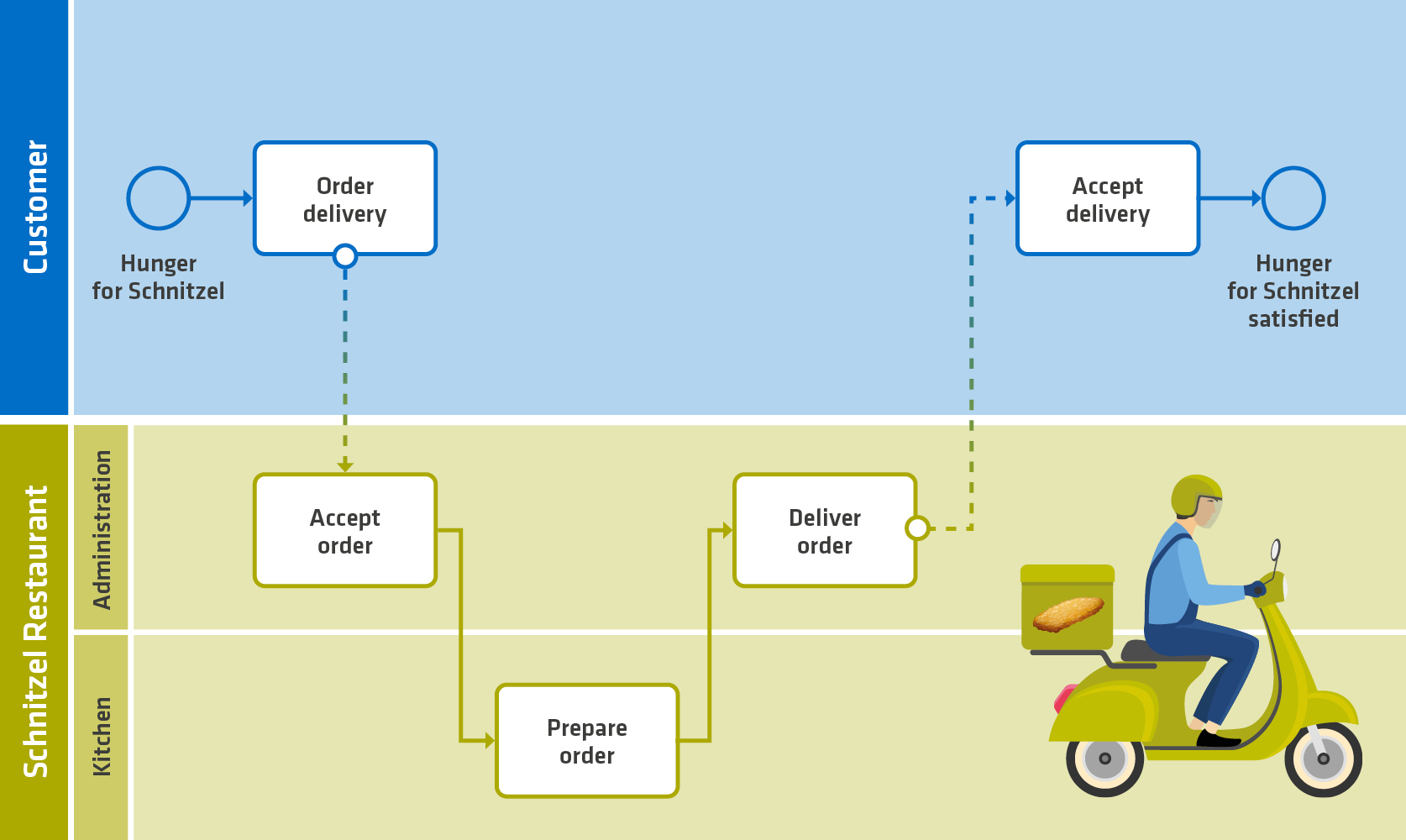In an ever faster-paced technological world, flexible tools are needed to adapt technologies and processes to new situations. One of these tools is Business Process Management and Notation (BPMN), which can accurately and intuitively represent business processes on many levels.
In the following, we outline what BPMNs are and how they can be applied. We also outline experiences in requirements engineering (RE) and business analysis for inventory management software in the occupational pension (bAV) industry).
What are BPMNs?
Business Project Management and Notation is a standardized, graphical process notation for business process management. This is popular in RE because sketching out processes makes abstract concepts more tangible. In this way, processes can be recorded and displayed within tight deadlines without having to read detailed documentation, most likely written in technical jargon. While text documentation is an important part of any development, visual representations can be quickly understood by non-experts.
The basic organization of this notation determines the participants in a process, and both the conditions and the procedures of how they interact with each other. Thus, "pools" define independent entities, such as a company, and "lanes" define individual departments or employees of that company. In this way, responsibilities can be precisely defined and remain visually organized.

BPMNs say more than 1,000 words.
Business processes differ in complexity, but they can be described in any level of detail when documenting them. While text is and will remain the standard, BPMNs provide a remedy when working with multidisciplinary or non-specialist stakeholders. This is because the visual approach allows complex processes and facts to be represented intuitively.
This is made possible, in particular, by the fact that the notation is standardized and is designed for a diverse audience. Thus, the actions to be represented are limited to elementary basic building blocks, and in addition, many intuitive icons are used for this purpose. This quickly builds understanding among inexperienced stakeholders, allowing them to engage more quickly, which has made a good impression in RE with our newest customers. Stakeholders, including management, clerks and developers, were all able to participate in the development of the desired business processes.
BPMNs can be applied flexibly!
Depending on the situation, BPMNs can be created in a wide variety of levels of detail. If the context is the presentation of strategy for leading positions, the processes presented can be limited to their main components and the "happy path", i.e. the ideal process flow. A process can be presented in more detail if it involves the individual action steps, for example, for employees. Alternative action steps can then be presented at this level, as well as simple decision rules. The deepest level of detail is reached in the technical documentation, where each individual step, handled by a person or by software, is represented.
Furthermore, BPMNs can also be restricted to the processes of individual participants. Thus, BPMNs can represent complex content for individual participants without having to consider the process flows of other participants. This is useful when the processes of individual participants need to be defined in detail.
Another advantage is reusability: if different processes share common features, individual details can be exchanged or these processes can even be merged. In addition, BPMNs are difficult to misinterpret, because the individual functions of all icons are strictly defined. This especially helps during the final development of the future software.
BPMNs save time
If you ask two people for their opinion, you will usually get more than two opinions. This phenomenon can also be seen here. So, in order to work out a process, it's a matter of putting on the blinders to avoid straying from the essentials. Not only do the opinions of a wide variety of stakeholders have to be brought together, but opinions and insights about the process also change over time. This means that BPMNs are constantly changing as they are captured. This involves a lot of time and effort, because all key stakeholders have to approve the business processes to be coordinated. As a result, the creation of BPMNs undergoes many iterations - but the simpler, visual approach, as opposed to the text-based form, can greatly speed up this activity, as processes can often be sorted with just a few glances. So, once development is complete, the processes are known to all stakeholders. Thus, we were able to complete the capture of the business processes much faster, which was perceived as very positive by customers as well as by adesso insurance solutions.
Being courageous
The visualization of processes offers a good overview of the entire process chain. This makes it easy to identify bottlenecks, redundancies and other obstacles. This can be an effective motivation to optimize process flows. While changing existing processes creates the risk of blocking the process and others altogether, it also presents an opportunity to stand out from the competition. Because many customers want to modernize their software, but not their processes. That's why during this process, it pays to help customers change processes - making small, incremental changes and improvements adds up!
From concept to application
Software for creating BPMNs often goes beyond mere conceptual design. Process modeling and process execution solutions can not only be used to develop these concepts, but also offer the possibility of actually controlling business processes. This kind of automatic control involves human collaboration as well as software components. BPMNs thus offer an incredible added value that goes far beyond documentation and optimization.
BPMNs make requirements engineering more efficient!
This tool is especially valuable when beginning to document a business process. Because BPMNs deliver results quickly. These results can be intuitively understood by nearly everyone, making customization by a wide variety of stakeholders easier. This leads to greater satisfaction for all involved, which can keep everyone motivated to move the project forward. While working with BPMNs can be intensive, you will see an equal amount of progress. Therefore, our recommendation is to use BPMNs extensively!


Do you have any questions or comments? Then please leave us a comment.